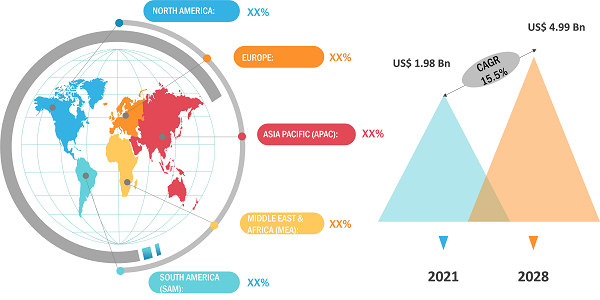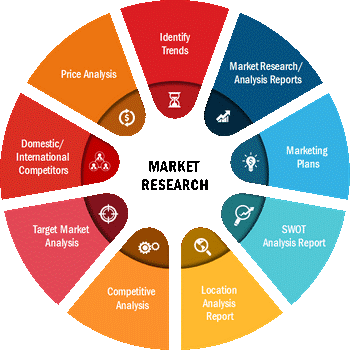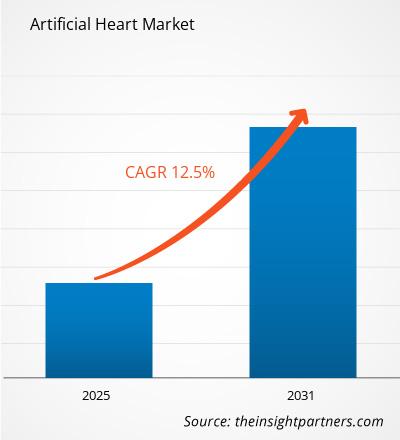Si prevede che il mercato dei cuori artificiali crescerà da 1,98 miliardi di dollari nel 2021 a 4,99 dollari miliardi entro il 2031; si prevede che crescerà a un CAGR del 15,5% dal 2022 al 2031.
Cuori artificiali, alimentati da aria compressa o elettricità, aiutano i pazienti con insufficienza cardiaca totale a vivere una vita normale oltre la loro aspettativa di vita o li aiutano a sopravvivere fino alla data del trapianto. Questi prodotti vengono utilizzati per sostituire completamente il cuore o solo per sostituire i ventricoli. Il dispositivo viene impiantato chirurgicamente nel torace per assistere un cuore deteriorato nelle sue funzioni. Un cuore artificiale può essere utilizzato temporaneamente e viene rimosso una volta che il cuore inizia a funzionare normalmente. Nei casi in cui il danno è grave, il cuore biologico viene completamente sostituito con un cuore artificiale.
DINAMICHE DEL MERCATO
Un aumento dell'incidenza dei disturbi cardiaci e un aumento della popolazione geriatrica guidano il mercato del cuore artificiale. Stili di vita impropri, che portano al peggioramento delle condizioni cardiache, potrebbero creare opportunità di crescita per i produttori di cuori artificiali. Tuttavia, il costo elevato delle valvole cardiache artificiali e le strutture di trattamento rigorosamente regolamentate sono i fattori che ostacolano la crescita del mercato.
AMBITO DI MERCATO
L'"Analisi del mercato globale dei cuori artificiali fino al 2031" Il rapporto mira a fornire una panoramica del mercato con una segmentazione dettagliata basata sul sistema. Il rapporto fornisce statistiche chiave di mercato basate sulle prestazioni dei principali attori. Descrive inoltre le principali tendenze e opportunità del mercato.
Approfondimenti strategici
SEGMENTAZIONE DEL MERCATO
Il mercato dei cuori artificiali è segmentato in base al sistema. In base al sistema, il mercato è biforcato in cuore artificiale, alimentatore e altri.
Il mercato del cuore artificiale è segmentato in cinque regioni principali: Nord America, Europa, Asia Pacifico, Medio Oriente e Asia. Africa e Sud & America Centrale. Il rapporto copre l'analisi e le previsioni di 18 paesi in tutto il mondo, insieme alle tendenze e alle opportunità prevalenti in ogni regione.
Il Nord America ha dominato il mercato dei cuori artificiali con una quota di circa il 49% nel 2021. La crescita del mercato nella regione è principalmente attribuita a un'elevata prevalenza di malattie cardiovascolari e neurologiche e a un'ampia popolazione geriatrica. I principali attori del mercato della regione utilizzano materiali di buona qualità e altri accessori per la produzione di valvole cardiache artificiali. Nel luglio 2022, la National Medical Products Administration cinese ha rilasciato l'approvazione alla commercializzazione per il cuore artificiale di un impianto domestico realizzato per casi di insufficienza cardiaca grave. Il cuore artificiale è un dispositivo di assistenza ventricolare sinistro impiantabile azionato da ferrofluidi. Nel febbraio 2021, Abbott ha ricevuto la designazione di dispositivo innovativo dalla Food and Drug Administration (FDA) statunitense per il suo sistema di assistenza ventricolare sinistra completamente impiantabile (FILVAS). La figura seguente illustra il trend di crescita dei ricavi nel mercato globale del cuore artificiale.

< span style="font-family: verdana, geneva, sans-serif; font-size: 10pt;">Fonte: The Insight Partners Analysis
Il rapporto analizza i fattori che influenzano il mercato del cuore artificiale, inclusi fattori trainanti, restrizioni, opportunità e tendenze future. Fornisce inoltre un'analisi esaustiva delle cinque forze di Porter del mercato.
< strong>IMPATTO DELLA PANDEMIA DA COVID-19
L'emergenza del COVID-19 ha costretto gli operatori sanitari a depriorizzare o posticipare le procedure terapeutiche, il che ha influito negativamente sulle vendite di dispositivi cardiovascolari, come i cuori artificiali, soprattutto nel 2021. Lo studio "The Impact of the COVID-19 Pandemic on Waiting Times for Elective Surgery Patients : A Multicenter Study", pubblicato nel luglio 2021, ha affermato che l'incidenza delle procedure elettive è diminuita rapidamente dopo l'inizio della prima ondata di COVID-19, nel marzo 2021; si è tuttavia registrata una ripresa nei mesi di maggio e giugno, dopo i quali l'incidenza degli interventi è stata superiore del 22% rispetto agli anni di riferimento. La pandemia, le conseguenti restrizioni sociali e la carenza di forza lavoro hanno ostacolato la produzione di valvole cardiache e materiali correlati.
GIOCATORI DEL MERCATO
Varie aziende nel mercato dei cuori artificiali si concentrano su strategie di crescita organica, come lanci di prodotti, approvazioni di prodotti, brevetti ed eventi. D’altra parte, strategie di crescita inorganica come acquisizioni, partnership e collaborazioni hanno anche aiutato gli operatori del mercato attraverso l’espansione del business e della base di clienti. Si prevede che gli operatori che operano nel mercato dei cuori artificiali sperimenteranno opportunità di crescita redditizie nei prossimi anni con la crescente domanda di prodotti per cuori artificiali.
Il rapporto include anche i profili dei principali attori del mercato del cuore artificiale, insieme alle loro analisi SWOT e strategie di mercato. Specifica inoltre i componenti e i servizi offerti da questi attori, insieme alle informazioni finanziarie degli ultimi tre anni e allo sviluppo chiave degli ultimi cinque anni. Di seguito è riportato l'elenco delle principali aziende impegnate nel mercato dei cuori artificiali:
- SynCardia Systems
- LLC, BiVACOR Inc.
- CARMAT
- Cleveland Heart, Inc .
- ABIOMED
- ON-X LIFE TECHNOLOGIES INC.
- Abbott
- Cirtec
- Thoratec Corporation
- MyLVAD
Il team di ricerca e analisi dedicato di Insight Partners è composto da professionisti esperti con competenze statistiche avanzate. Il team offre varie opzioni di personalizzazione nello studio esistente.
< br>
- Analisi storica (2 anni), anno base, previsione (7 anni) con CAGR
- Analisi PEST e SWOT
- Valore/volume delle dimensioni del mercato - Globale, regionale, nazionale
- Industria e panorama competitivo
- Set di dati Excel



Report Coverage
Revenue forecast, Company Analysis, Industry landscape, Growth factors, and Trends

Segment Covered
This text is related
to segments covered.

Regional Scope
North America, Europe, Asia Pacific, Middle East & Africa, South & Central America

Country Scope
This text is related
to country scope.
Domande frequenti
The Artificial Heart Market is estimated to witness a CAGR of 12.5% from 2023 to 2031
The major factors driving the Artificial Heart Market are:
1.Increasing Prevalence of Cardiovascular Diseases
2. Government Initiatives and Funding
3. Improved Surgical Techniques
North America region dominated the Artificial Heart Market in 2023
Asia Pacific region dominated the Artificial Heart Market in 2023
The Left Ventricular Assist Devices (LVAD)
segment accounts for highest revenue in product the Artificial Heart Market in 2023
SynCardia Systems, Cleveland Heart, Inc., BiVACOR Inc., Abbott accounting for higesh market shares and are some of the major players operating in the market
Trends and growth analysis reports related to Life Sciences : READ MORE..
The List of Companies
1. SynCardia Systems, LLC
2. BiVACOR Inc.
3. CARMAT
4. Cleveland Heart, Inc.
5. ABIOMED
6. ON-X LIFE TECHNOLOGIES INC
7. Abbott
8. Cirtec
9. Thoratec Corporation
10. MyLVAD
The Insight Partners performs research in 4 major stages: Data Collection & Secondary Research, Primary Research, Data Analysis and Data Triangulation & Final Review.
- Data Collection and Secondary Research:
As a market research and consulting firm operating from a decade, we have published and advised several client across the globe. First step for any study will start with an assessment of currently available data and insights from existing reports. Further, historical and current market information is collected from Investor Presentations, Annual Reports, SEC Filings, etc., and other information related to company’s performance and market positioning are gathered from Paid Databases (Factiva, Hoovers, and Reuters) and various other publications available in public domain.
Several associations trade associates, technical forums, institutes, societies and organization are accessed to gain technical as well as market related insights through their publications such as research papers, blogs and press releases related to the studies are referred to get cues about the market. Further, white papers, journals, magazines, and other news articles published in last 3 years are scrutinized and analyzed to understand the current market trends.
- Primary Research:
The primarily interview analysis comprise of data obtained from industry participants interview and answers to survey questions gathered by in-house primary team.
For primary research, interviews are conducted with industry experts/CEOs/Marketing Managers/VPs/Subject Matter Experts from both demand and supply side to get a 360-degree view of the market. The primary team conducts several interviews based on the complexity of the markets to understand the various market trends and dynamics which makes research more credible and precise.
A typical research interview fulfils the following functions:
- Provides first-hand information on the market size, market trends, growth trends, competitive landscape, and outlook
- Validates and strengthens in-house secondary research findings
- Develops the analysis team’s expertise and market understanding
Primary research involves email interactions and telephone interviews for each market, category, segment, and sub-segment across geographies. The participants who typically take part in such a process include, but are not limited to:
- Industry participants: VPs, business development managers, market intelligence managers and national sales managers
- Outside experts: Valuation experts, research analysts and key opinion leaders specializing in the electronics and semiconductor industry.
Below is the breakup of our primary respondents by company, designation, and region:

Once we receive the confirmation from primary research sources or primary respondents, we finalize the base year market estimation and forecast the data as per the macroeconomic and microeconomic factors assessed during data collection.
- Data Analysis:
Once data is validated through both secondary as well as primary respondents, we finalize the market estimations by hypothesis formulation and factor analysis at regional and country level.
- Macro-Economic Factor Analysis:
We analyse macroeconomic indicators such the gross domestic product (GDP), increase in the demand for goods and services across industries, technological advancement, regional economic growth, governmental policies, the influence of COVID-19, PEST analysis, and other aspects. This analysis aids in setting benchmarks for various nations/regions and approximating market splits. Additionally, the general trend of the aforementioned components aid in determining the market's development possibilities.
- Country Level Data:
Various factors that are especially aligned to the country are taken into account to determine the market size for a certain area and country, including the presence of vendors, such as headquarters and offices, the country's GDP, demand patterns, and industry growth. To comprehend the market dynamics for the nation, a number of growth variables, inhibitors, application areas, and current market trends are researched. The aforementioned elements aid in determining the country's overall market's growth potential.
- Company Profile:
The “Table of Contents” is formulated by listing and analyzing more than 25 - 30 companies operating in the market ecosystem across geographies. However, we profile only 10 companies as a standard practice in our syndicate reports. These 10 companies comprise leading, emerging, and regional players. Nonetheless, our analysis is not restricted to the 10 listed companies, we also analyze other companies present in the market to develop a holistic view and understand the prevailing trends. The “Company Profiles” section in the report covers key facts, business description, products & services, financial information, SWOT analysis, and key developments. The financial information presented is extracted from the annual reports and official documents of the publicly listed companies. Upon collecting the information for the sections of respective companies, we verify them via various primary sources and then compile the data in respective company profiles. The company level information helps us in deriving the base number as well as in forecasting the market size.
- Developing Base Number:
Aggregation of sales statistics (2020-2022) and macro-economic factor, and other secondary and primary research insights are utilized to arrive at base number and related market shares for 2022. The data gaps are identified in this step and relevant market data is analyzed, collected from paid primary interviews or databases. On finalizing the base year market size, forecasts are developed on the basis of macro-economic, industry and market growth factors and company level analysis.
- Data Triangulation and Final Review:
The market findings and base year market size calculations are validated from supply as well as demand side. Demand side validations are based on macro-economic factor analysis and benchmarks for respective regions and countries. In case of supply side validations, revenues of major companies are estimated (in case not available) based on industry benchmark, approximate number of employees, product portfolio, and primary interviews revenues are gathered. Further revenue from target product/service segment is assessed to avoid overshooting of market statistics. In case of heavy deviations between supply and demand side values, all thes steps are repeated to achieve synchronization.
We follow an iterative model, wherein we share our research findings with Subject Matter Experts (SME’s) and Key Opinion Leaders (KOLs) until consensus view of the market is not formulated – this model negates any drastic deviation in the opinions of experts. Only validated and universally acceptable research findings are quoted in our reports.
We have important check points that we use to validate our research findings – which we call – data triangulation, where we validate the information, we generate from secondary sources with primary interviews and then we re-validate with our internal data bases and Subject matter experts. This comprehensive model enables us to deliver high quality, reliable data in shortest possible time.

 Ottieni un campione gratuito per questo repot
Ottieni un campione gratuito per questo repot